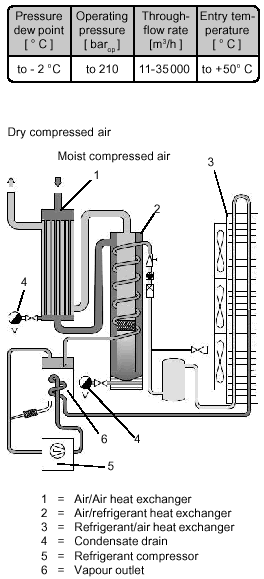<BR> Fig. 5.8: Op. diagram of a refrigeration compressed air dryer
Fig. 5.8: Op. diagram of a refrigeration compressed air dryer | When the temperature falls, air loses its ability to hold water. To reduce the moisture content, compressed air can be cooled down in a refrigeration dryer.
Refrigeration drying is a process by which compressed air is cooled down by a dryer in a heat exchanger. The moisture contained in the air precipitates in the form of condensate. The quantity of condensate that precipitates rises with the difference between the entry and exit temperature of the compressed air.
Operating principle
Refrigeration drying runs in two phases. This is done to improve effectiveness and to obtain maximum use of the refrigerant.
1st Phase
Inside an air/air heat exchanger the compressed air already cooled by the refrigeration dryer cools new air flowing in. 70 % of the moisture contained in the air precipitates here in the form of condensate.
2nd Phase
The compressed air flows through a refrigerant/air heat exchanger and cools down almost to freezing point. The precipitated condensate is directed off before re-heating in the first cooling phase.
Features:
- Highly economical. Refrigeration drying is the most economical process in approx. 90 % of all applications.
- Separation of impurities. Almost 100 % of all solid particles and water droplets larger than 3µm are separated.
- Lower pressure loss in the dryer. The pressure loss Dp from the dryer is approx. 0,2 bar. <BRB
|